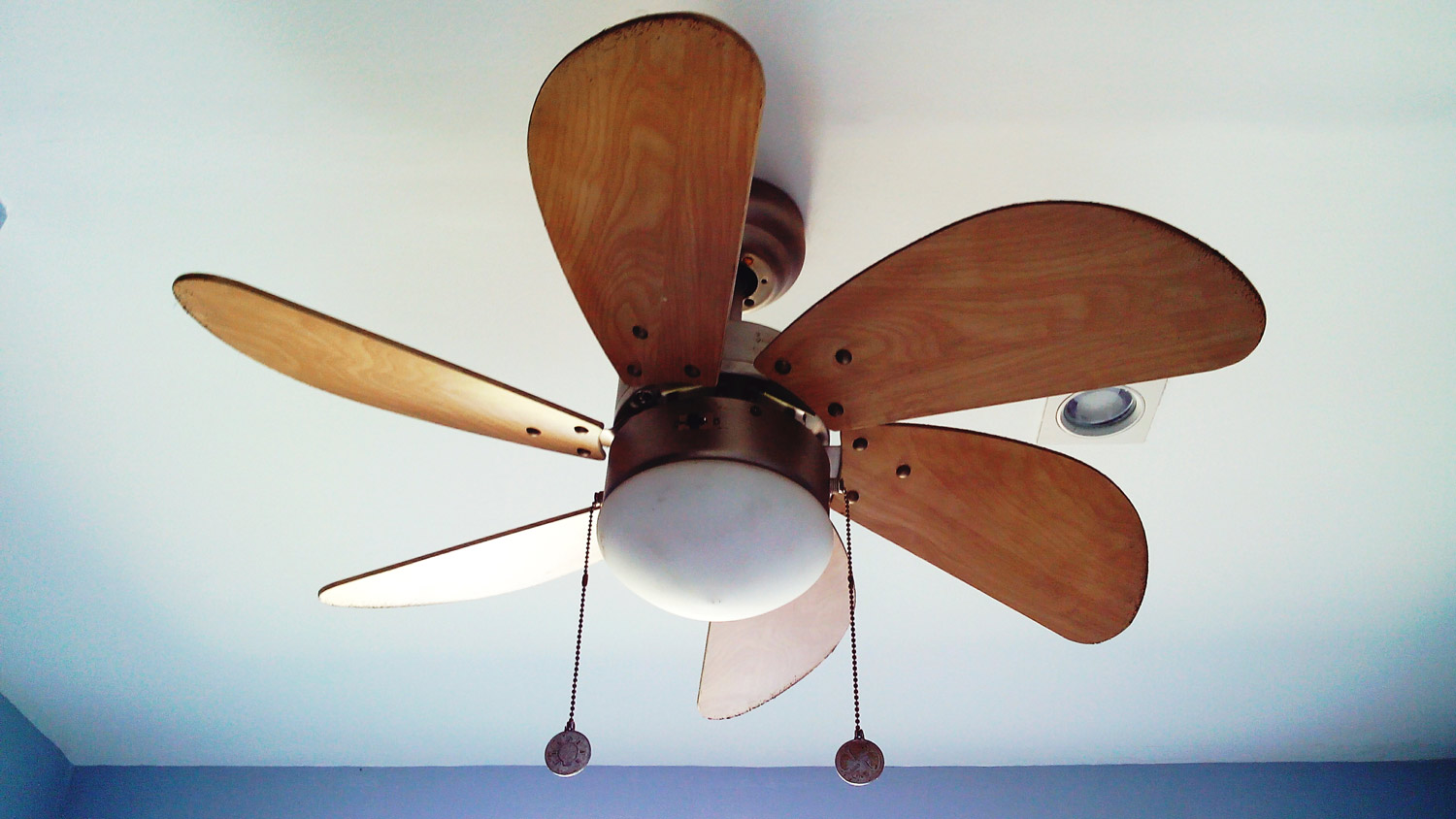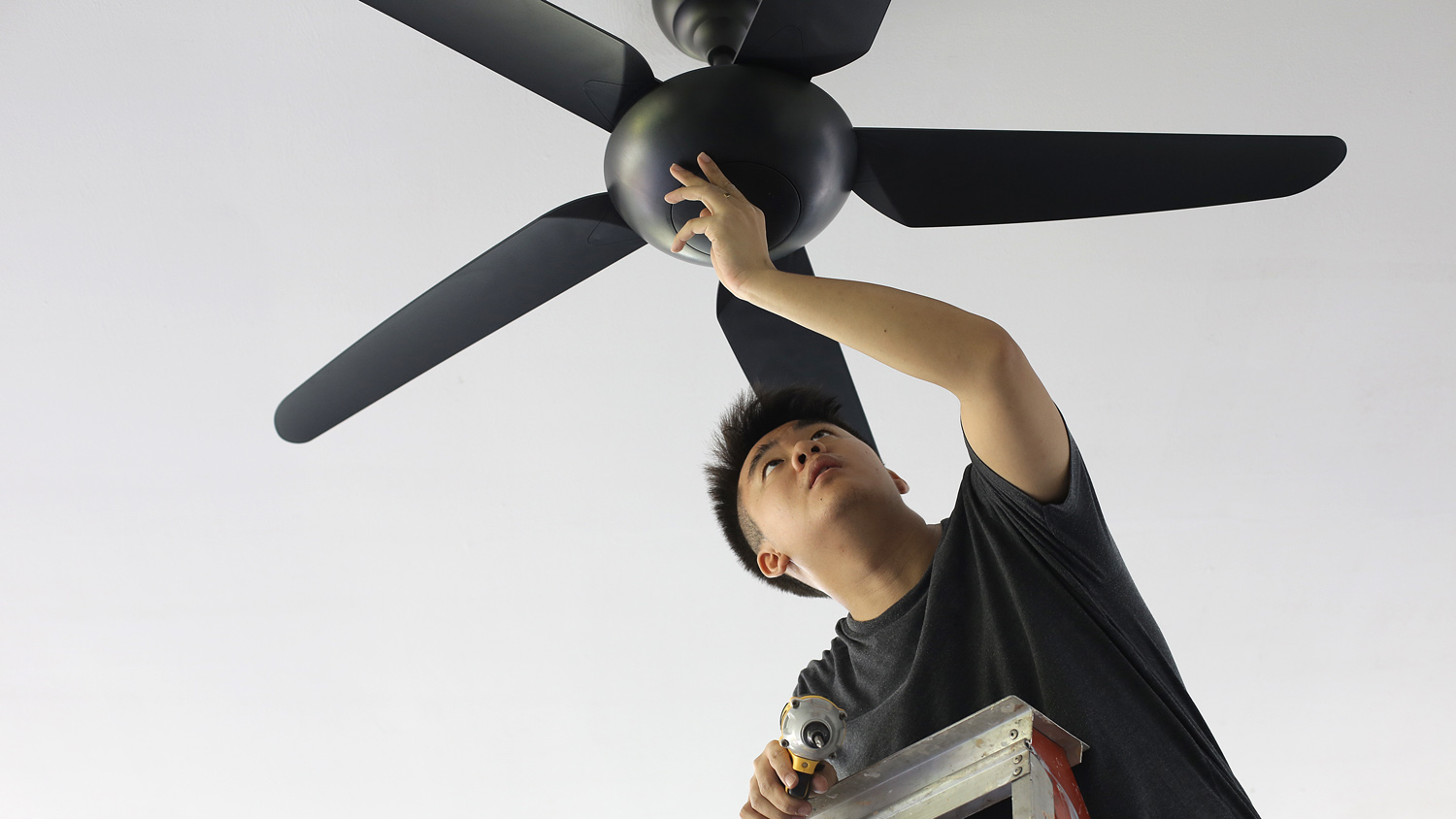
If your ceiling fan stops working due to a bad motor or broken pull chain, here’s what you can expect to pay to get it fixed.
Give these troubleshooting tips a whirl


Troubleshoot ceiling fan operation by checking wall switches, remotes, and pull chains first.
Blade blockages and imbalances are common culprits for a ceiling fan that isn’t working.
Most ceiling fans last 10 to 15 years with regular maintenance.
Internal failures like bad wiring or a broken motor usually require the help of a pro.
If your ceiling fan isn’t spinning, the problem could be something as straightforward as a stuck switch or a blocked blade. In more rare cases, it might point to a deeper issue inside the fan. In some cases, you can fix the problem yourself, but some problems require professional expertise. Use this guide to identify the most common reasons a ceiling fan stops spinning and figure out which fixes are safe to try on your own and which ones call for a licensed electrician.

If your ceiling fan isn’t spinning, start by confirming that it’s actually turned on. Many ceiling fans rely on a combination of wall switches, pull chains, and remote controls, and if any of these aren’t engaged, the fan won’t move.
Flip the wall switch to the “on” position, even if it already looks like it’s on. Sometimes toggling it resets the connection.
Pull the fan’s chain once or twice to make sure it’s not stuck between speed settings.
If your fan uses a remote, replace the batteries and try turning the fan on again.
Ceiling fan blades can get blocked by debris, tangled pull chains, or loose screws inside the cover. And in some cases, warped or drooping blades can throw the fan off balance and stop it from turning altogether.
Make sure the fan is turned off before inspecting the blades.
Look for anything that could be preventing the blades from moving, like tangled cords or dust buildup around the motor cover.
Inspect each blade for signs of warping or sagging edges.
Make sure all blade screws are tightened securely.
If the fan still won’t spin, continue to the next step.
Many ceiling fans have a switch or dial you can use to control how fast the blades spin. This might be part of a wall switch, a remote, or a built-in control on the fan itself. If this part stops working, the fan may stop responding altogether, even if it’s still getting power.
If your fan uses a wall-mounted speed control, try turning it through all settings to see if the fan responds.
If the wall switch feels loose, unresponsive, or doesn’t click firmly into place, it may need to be replaced.
If the fan uses a remote, replace the batteries and reset the remote connection using the manufacturer’s instructions.
If the fan still doesn’t respond, proceed to the next step.
Some ceiling fans also have a small switch that changes the direction the blades spin. You can usually find it on the motor housing, which is the round part of the fan just above the blades where the fan meets the ceiling. If the switch is stuck between positions or not fully clicked into place, the fan may stop working altogether.
Turn off the fan using the wall switch or pull chain.
Find the direction switch on the motor housing.
Push the switch in one direction, click it into place.
Turn the fan back on and check whether the blades start to spin.
If the fan still doesn’t move, continue to the next step.

If your fan isn’t responding at all, meaning no movement, no sound, and no lights turning on, it may not be receiving power. A tripped circuit breaker, blown fuse, or loose wiring connection at the ceiling box can interrupt the flow of electricity and prevent the fan from spinning. This is especially common after storms, power outages, or recent electrical work in the home.
Check your electrical panel for a tripped breaker. Look for a switch that’s out of line with the others.
If you find a tripped breaker, flip it fully to the “off” position, then back to “on.”
Try turning the fan on again using the switch, chain, or remote.
If the ceiling fan spins briefly but the breaker trips again right away, stop and contact a licensed electrician. There may be a deeper electrical issue.
If the breaker isn’t tripped and the fan still won’t respond, continue working through the next steps. It may be an issue inside the fan housing or motor.
If your ceiling fan isn’t spinning but has power, the problem could be with the wiring inside the fan housing. Over time, the fan’s vibrations can cause wire connections to loosen or shift. This is especially common if the fan was installed recently or has started wobbling. In some cases, a connection may have been faulty from the start and just now worked its way loose enough to stop functioning altogether.
Turn off the power to the fan at the breaker box to avoid any risk of shock.
Remove the cover at the base of the fan where it connects to the ceiling.
Check for any loose, disconnected, or damaged wires.
If you see signs of burning, fraying, or corrosion, stop and call a licensed electrician for ceiling fan repairs.
If wires are simply loose, you can tighten the wire connectors by hand and secure them.
Replace the cover and turn the power back on.
If the fan still doesn’t spin, there may be a deeper electrical issue.
The capacitor is a small component inside the fan that helps the motor start spinning. If it fails, the motor may still hum, but the blades won’t move. This is one of the most common internal issues in ceiling fans, especially in older fans or fans that have seen a lot of use.
Turn off the power to the fan at the breaker box.
Remove the cover at the base of the fan where it connects to the ceiling.
Look for a small, cylindrical or oval-shaped component with wires connected to it. This is the capacitor.
If the capacitor looks swollen, burnt, or is leaking fluid, stop and contact a licensed electrician right away. Do not attempt to replace the capacitor yourself because it can hold a charge even when the power is off, resulting in injury.
A broken motor is another reason your fan might have power but not spin. Over time, ceiling fan motors can wear out from heavy use, overheating, or just age. In some cases, the motor will hum without turning the blades. In others, it may stop responding entirely, even though the fan is still receiving power.
Turn off the power to the fan at the breaker box.
Try turning the blades gently by hand. If they spin freely but the fan won’t start, the motor may be broken.
Do not attempt to repair or take apart the motor yourself. Contact a licensed electrician or ceiling fan technician to inspect the fan and confirm if the motor has failed.
If the motor needs to be replaced, it’s usually more cost-effective to install a new ceiling fan.
Some ceiling fans have built-in thermal protection, also known as a feature that shuts off the motor if the fan begins to overheat. This can happen if the fan has been running continuously for long periods. If there’s poor airflow around the motor or if dust buildup is preventing proper ventilation, this protection will kick in. Once the motor cools down, the fan may begin working again without any warning or explanation, which can make the issue tricky to identify.
Turn off the fan and let it sit for at least 30 minutes to allow the motor to cool completely.
Check for dust buildup around the motor housing and vents, then clean the area gently with a dry cloth or vacuum attachment.
Make sure nothing is blocking airflow near the ceiling or around the blades.
If the fan works again after cooling down, avoid running it for extended periods without breaks.
If the fan continues shutting off, contact a licensed electrician.
If your ceiling fan is more than 10 to 15 years old, it may have reached the end of its life. Over time, internal components like bearings, wiring, and insulation can break down, even if the fan has been working without issue until now. Older fans are also more likely to suffer from multiple small failures at once, which can stop the blades from spinning entirely.
Check the age of your fan if you can. Many manufacturers include the date on a sticker inside the cover.
If the fan is over a decade old and none of the other troubleshooting steps have helped, it’s likely time for a replacement.
Some ceiling fan issues can be safely addressed as a DIY remedy, but others involve internal wiring or electrical components that require a licensed professional. If you’ve worked through the simpler steps and your fan still isn’t spinning, it’s time to bring in an expert.
Call a pro if you notice any of the following:
The fan’s wiring is loose, frayed, or burned
The capacitor is swollen, leaking, or visibly damaged
The motor is unresponsive or humming but not spinning
The fan repeatedly shuts off due to overheating
A licensed electrician can safely diagnose the problem and let you know whether a repair or full replacement makes more sense.
Dust the blades and motor housing regularly: Buildup can cause blade imbalances, overheating, and blocked airflow, all of which can wear down internal components over time.
Tighten the blade screws every few months: Loose screws can lead to wobbling, which strains the motor and increases the chance of wiring issues.
Avoid running the fan nonstop: Give your fan breaks during the day to prevent overheating and reduce long-term motor stress.
Keep pull chains untangled: This prevents them from catching in the blades or interfering with movement.
Schedule a ceiling fan inspection every few years: A licensed electrician can check wiring connections, motor health, and control systems before they fail.
From average costs to expert advice, get all the answers you need to get your job done.

If your ceiling fan stops working due to a bad motor or broken pull chain, here’s what you can expect to pay to get it fixed.

Discover the cost to install a ceiling fan, including labor, materials, and tips to save. Learn what impacts your price and how to budget for your project.

Ceiling fans should run fairly quietly. Learn about the causes of excessive rattling, clicking, or other odd sounds and how to fix your noisy ceiling fan.

Hiring an electrician to install a ceiling fan will make the process safer and easier. But before contacting a pro, ask yourself these ceiling fan questions.

If your ceiling fan is wobbling, it’s likely a simple problem. Check out these common reasons why your ceiling fan wobbles and their quick solutions.

Most ceiling fans should be reasonably quiet most of the time. Learn why your ceiling fan is making noise and how you can fix these common problems